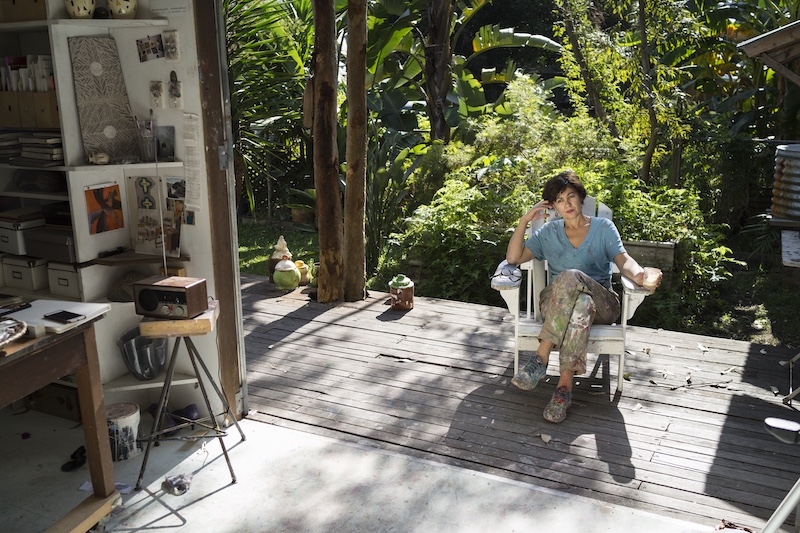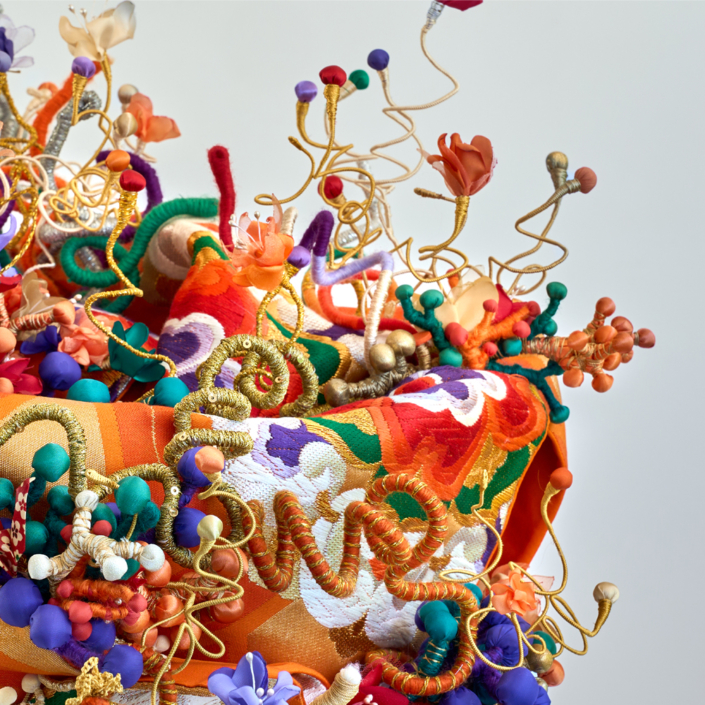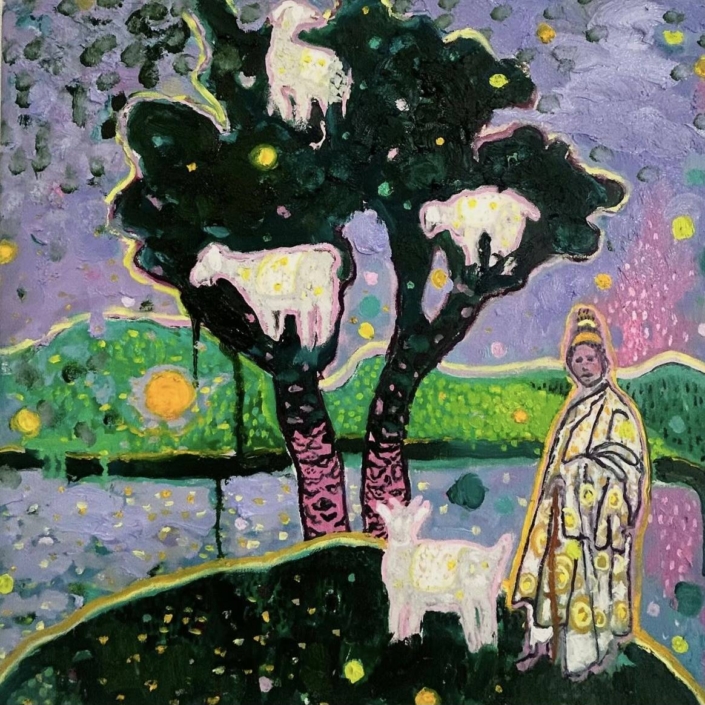Ildiko Kovacs: Choreographer of Colour
Instinct is what drives Ildiko Kovacs, but that level of trust only comes with years of painting and pushing.
Words: Gina Fairley
Photography: Stephen Oxenbury
It has been two years since Ildiko Kovacs won the significant Bulgari Art Award (2015), presented in partnership with the Art Gallery of NSW. Such prizes can often be waymakers in a career, offering a point of reflection and a spur forward. But for Kovacs, she views her work as a continuum. “It is not like this is a body of work done, and then I sit back and think about the next one. The changes are incremental and evolve over time. Each painting is its own experience,” she said.
Kovacs’ exhibition at Martin Browne Contemporary (27 July – 20 August 2017) is the next page in that evolution, a group of big, bold abstractions that seeming take a line for a walk.
How does Kovacs keep that freshness in her line and gesture after a career of 30 plus years? “A lot of turps,” she laughed. Kovacs goes through about 20 litres of turps a month. Working arms outstretch in a bodily engagement at close range, she persistently applies paint, wipes it back, applies, wipes, constantly reworking to the point of exhaustion. This is painting at is most physical extreme.
“Whatever residue is left that is where I pick up from; it’s a kind of emptying out and building up at the same time,” said Kovacs. She will turn her boards about 20 times a day in the process of painting the eye-catching connections between lines and form. The line has always been her fundamental building block, and she will wrestle with it until it surprises her, teasing it out in a high contrast palette.
This new group of paintings is no different. Ca- nary yellow over lavender, soft grey over shocking pink, pewsy lime over earthy tones – there is a kind of retinal twang that happens when standing in front of these paintings, which seem to pop off white walls and seduce with their intensity. They have a clarity and impact that few artists can command.
For this new exhibition that three-dimensionality, or “punch”, is particularly prevalent as darker gestures levitate over lighter grounds, stacking the space more literally. You seem to fall back into these paintings. Lotus (2017), for example, walks the viewer back through a schema of black to green, to earthy browns, reds and a final hint of blue. The longer you spend with these paintings the more they reveal.
“I like that feeling of working into and behind the work,” said Kovacs. Across this new show, Kovacs’ line continues to flirt with the edge of her paintings, sparking a tension that is intriguing. They are both spontaneous and fluid and yet confined. I am reminded of the earliest video game by Atari, Pong, where the player controlled an in-field movement, distilled to the most elementary gesture, but riveting – addictive.
Kovacs ratchets up the intensity with her preferred tool – the paint roller – which she has used for over a decade now and has successfully mastered into a language that has an internal pulse or staccato as paint is pushed across the picture plane.
The choice of a lighter sponge allows the light to penetrate and the line to hover over another, as in the painting Outback (2017) where a seeming banal black line twists and dances and stacks across itself, building depth and density on an earthy orange field. It is electric.
Instinct is what drives Kovacs, but that level of trust only comes with years of painting and pushing. She explained, “If I put the line down it is almost sculptured – pushed around, wiped off and painted again – there’s a rhythm created and at a point the paint and the board are in dialogue. It often happens when you can’t go any further; you are completely exhausted and it is because you are completely resigned that you find the mark. It is that fantastic thing in painting where, time and time again, you realise it is just about letting go and not getting in the way of yourself. It is about trust and not being precious.” Kovacs lives at Bundeena, on the edges of the Royal National Park in Sydney’s South. She has been showing with Martin Browne Contemporary since 2001, and has mounted over 20 solo exhibitions across her career. Kovacs’ work is represented in major collections nationally, and her 2011 survey exhibition, Down the Line curated by Daniel Mudie Cunningham for Hazelhurst Regional Gallery & Art Centre, was accompanied by a major monograph.
MARTIN BROWNE, Director, Martin Browne Contemporary, Sydney
“I initially became familiar with Ildiko Kovacs’ paintings as far back as 1989-91, but the first time they really struck me was at a solo exhibition she staged at the Mary Place Gallery, Paddington in 1997.
“Kovacs’ work has evolved enormously since then, but there are core elements that have remained constant: her relationship to the world around her, both physical and emotional, that finds expression in abstract imagery; her employment of a wandering line to describe shapes, create depth and develop perspective; and her intuitive use of colour, texture, layering and erasure to build up images of emotional power.
“I am compelled by Kovacs’ work equally as a collector as I am as a dealer. I own and live with several of her paintings. One of Kovacs’ early ‘roller works’, Purple Sea (2010), is the first painting I see each morning and its mesmerising dance of greens over a purple field still enchants me the same way it did when I first saw it in her 2011 survey exhibition at Hazelhurst Regional Gallery & Arts Centre.
“It was from this time, which coincided with the beginning of the ‘roller works’, that demand for Kovacs’ paintings increased steadily. This has continued, fuelled first by the strong sales at the Laverty Collection auction, which widened her audience and showed there was a serious secondary market for her work, and second by her receiving the prestigious 2015 Bulgari Art Award, which led to the Art Gallery of NSW acquiring Onda (2015). Now there is a waiting list for new paintings and her exhibitions routinely sell out. Yet through all this Kovacs has kept resolutely to her path, exploring new directions and creating extraordinary paintings.” – Paris Lettau
DANIEL MUDIE CUNNINGHAM Assistant Director and Head Curator Artbank, Sydney
“In 2011, I curated a survey exhibition at Hazelhurst Regional Gallery & Arts Centre titled lldiko Kovacs: Down the Line 1980-2010. As a local artist to the region, living and working in Bundeena, Kovacs was and continues to be an important figure and role model for many artists. Her national profile imbues her with local hero status.
“Working with Kovacs at that time, I witnessed her work undertake a significant paradigm shift when she started using the humble paint roller to create form. During this period, she executed the intense gestural mark-making of her paintings on the floor of her studio. The passion of Kovacs’ work is that she pummels herself into the ground of her work, flipping the male heroism of the action painter with a macho feminised twist. The raw emotion of her contouring, looping line-work with all the heat and the love she puts into it, requires from her a visceral, corporeal throw-down. I have previously quoted Paul Klee in relation to Kovacs’ work, who famously said that the line “goes out for a walk so to speak, aimlessly for the sake of a walk.” Kovacs doesn’t walk the line as much as she dances it into a frenzied state of being.
“Kovacs fascinates me as an artist, her self- determination, her staunch discipline, but also her utter commitment to the affective labour of gestural abstraction. She is a great colourist, her palate crackles with intensity, a stiff drink for a retina otherwise often awash with mediocrity and ennui.” – Paris Lettau
HUGO MICHELL, Director, Hugo Michell Gallery, Adelaide
Hugo Michell was introduced to Ildiko Kovacs’ work through Colin and Liz Laverty, the extraordinary figures behind Australia’s preeminent Laverty Collection. “They have always been huge supporters of hers. They collected her work straight out of her graduate exhibition at art school.” Today, Kovacs is one of Michell’s established artists whom he has represented since the gallery opened in 2008.
What stands out for Michell is the unique painterly language Kovacs has developed through her remarkable handling of colour depth and texture. “If you’ve ever spent time with one of her paintings you appreciate their subtlety—the changes that occur throughout the day as the light changes.” It makes for a distinctive style, and yet she still manages to “push each body of work into new territory.”
Kovacs’ work is also very accessible. She has a diverse appeal not only among major public and private collections like the National Gallery of Australia, the Museum of Contemporary Art, Art Gallery of New South Wales and the Laverty Collection, but also among collectors who are only just starting out. Her works have also been getting consistently strong results in the secondary market which, as Michell notes, is “exceptional in the current economic climate.” And receiving the prestigious 2015 Bulgari Art Award attest even further to Kovacs’ artistic importance and value. “Without a doubt,” says Michell, “she’s one of Australia’s most important living abstract painters.” – Paris Lettau
The work of Ildiko Kovacs will be presented by Martin Browne Contemporary, Sydney from 27, July – 20 August 2017. The artist is also represented by Hugo Michell Gallery, Adelaide.
This article was originally published in Art Collector issue 81, JUL-SEP, 2017.









